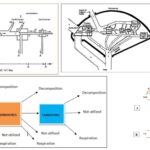IB Biology 16 Views 1 Answers
Sourav PanLv 9November 7, 2024
How can the fluid mosaic model be represented in a drawing?
How can the fluid mosaic model be represented in a drawing?
Please login to save the post
Please login to submit an answer.
Sourav PanLv 9May 15, 2025
To represent the fluid mosaic model in a drawing, it is essential to capture the key components and their arrangement within the cell membrane. The fluid mosaic model illustrates how the plasma membrane is structured as a dynamic and flexible barrier composed of various molecules. Here’s a step-by-step guide on how to create an accurate representation of the fluid mosaic model:
Key Components to Include
- Phospholipid Bilayer:
- Structure: Draw two layers of phospholipids with hydrophilic heads facing outward (towards the aqueous environment) and hydrophobic tails facing inward (towards each other).
- Label: Clearly label the heads as “Hydrophilic Heads” and the tails as “Hydrophobic Tails.”
- Integral Proteins:
- Structure: Illustrate proteins that span across the bilayer (transmembrane proteins) and those that are partially embedded (monotopic proteins).
- Label: Indicate these as “Integral Proteins” or “Transmembrane Proteins.”
- Peripheral Proteins:
- Structure: Draw smaller proteins located on the inner or outer surface of the membrane, not embedded within the lipid bilayer.
- Label: Mark these as “Peripheral Proteins.”
- Cholesterol Molecules:
- Structure: Represent cholesterol molecules interspersed among the phospholipid tails to indicate their role in maintaining membrane fluidity.
- Label: Clearly label them as “Cholesterol.”
- Carbohydrates:
- Structure: Illustrate carbohydrate chains attached to proteins (glycoproteins) or lipids (glycolipids) on the extracellular surface of the membrane.
- Label: Indicate these as “Carbohydrate Chains.”
- Fluidity Representation:
- To convey fluidity, you can use arrows or wavy lines around the components to suggest movement within the membrane.
Steps for Drawing
- Base Structure:
- Start by drawing two parallel lines to represent the phospholipid bilayer, ensuring that the hydrophilic heads are drawn outward and hydrophobic tails inward.
- Add Proteins:
- Sketch integral proteins crossing through the bilayer and peripheral proteins on either side of it.
- Include Cholesterol:
- Insert small, oval shapes between phospholipid tails to represent cholesterol.
- Draw Carbohydrates:
- Add branching lines extending from some proteins or lipids to depict carbohydrate chains.
- Label Components:
- Use clear, legible text to label each component of your drawing, ensuring that all parts are identified correctly.
- Final Touches:
- Review your drawing for clarity and accuracy, ensuring that it visually represents the dynamic nature of the fluid mosaic model.
0
0 likes
- Share on Facebook
- Share on Twitter
- Share on LinkedIn
0 found this helpful out of 0 votes
Helpful: 0%
Helpful: 0%
Was this page helpful?




